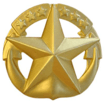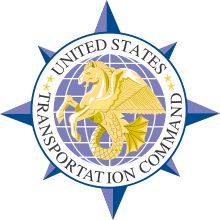Dee Mewbourne
Dee Leon Mewbourne (born December 9, 1961) is a vice admiral in the United States Navy, serving as deputy commander of United States Transportation Command since July 2019.[1][2] He graduated from the United States Naval Academy in 1982 and was designated a naval flight officer in December 1983. He later earned a master’s degree in business administration from Colorado State University. He is an honor graduate of the U.S. Naval Test Pilot School and completed the Navy’s Nuclear Power Program, Air Command and Staff College (ACSC), Joint Forces Staff College and numerous executive educational courses.
Dee Leon Mewbourne | |
|---|---|
 VADM Mewbourne as Deputy, USTRANSCOM | |
| Born | December 9, 1961 Ormond Beach, Florida |
| Allegiance | |
| Service/ | |
| Years of service | 1982–present |
| Rank | |
| Commands held | Military Sealift Command Carrier Strike Group 11 Carrier Strike Group 3 Naval Service Training Command USS Harry S. Truman (CVN 75) USS Enterprise (CVN 65) USS Dwight D. Eisenhower (CVN 69) USS Nashville (LPD-13) VAQ-139 |
| Battles/wars | Gulf War |
| Awards | Navy Distinguished Service Medal Defense Superior Service Medal Legion of Merit (7) |
Mewbourne’s command assignments include: Electronic Attack Squadron (VAQ) 139 aboard USS Abraham Lincoln (CVN 72), USS Nashville (LPD 13), USS Dwight D. Eisenhower (CVN 69), USS Enterprise (CVN 65), USS Harry S. Truman (CVN 75), Naval Service Training Command (NSTC), Carrier Strike Group (CSG) 3, CSG-11, and Military Sealift Command.
At sea, Mewbourne completed sea assignments flying the A-6E Intruder aircraft in Attack Squadron (VA) 34 embarked aboard USS America (CV 66); VA-75 aboard USS John F. Kennedy (CV 67); Carrier Air Wing (CVW) 3 aboard Eisenhower; and as the XO (executive officer) of VA-196 aboard USS Carl Vinson (CVN 70). After transitioning to the EA-6B Prowler aircraft, he served as the executive officer of VAQ-139 aboard Abraham Lincoln. He also served as the executive officer on USS George Washington (CVN 73).
Ashore, Mewbourne served as a flight instructor with VA-42, the East Coast A-6E Fleet Replacement Squadron (FRS), and project officer at the Strike Aircraft Test Directorate. Later, he served as military assistant and trip coordinator for the secretary and deputy secretary of defense; chief of staff for Navy Cyber Forces; on the staff of Commander, Naval Air Force Atlantic; and director, Maritime Operations for U.S. Fleet Forces Command.
Awards and decorations
 | ||
 | ||
- While at the Naval Academy, he received the Carl Vinson Leadership Award.
- Upon completion of initial flight training in the A-6E Intruder at VA-42 in 1985, he was selected as the Replacement Bombardier/Navigator of the Year.
- In 1987, he was selected as the East Coast A-6 community’s Junior Intruder of the Year.
- In August 2012, he was awarded the Truman Foundation Leadership Award for inspirational leadership.